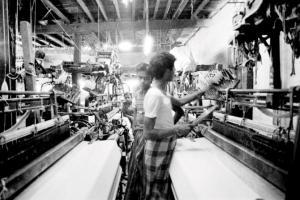A Dutch anthropologist presents an exhaustive study of the Bombay textile strike in a new book

Lack of space between the looms with their rotating parts and flying shuttles posed great danger to the workers and at times, led to serious injuries. Pic/Hub van Wersch
Step into the gentrified spaces in Lower Parel today — teeming with eateries and clothing stores — and it's easy to brush aside the idea of struggle and pain. That's precisely why you would do well to pick up the recently released reprint of Hub Van Wersch's The 1982–83 Bombay Textile Strike and the Unmaking of a Labourers' City (Speaking Tiger); a comprehensive analytical account of the subject, delving into aspects ranging from the textile industry and working conditions to the role of unions and cases of violence.
ADVERTISEMENT
Edited excerpts from an interview with the author.
What prompted this study?
I was in India at the time the strike was unfolding. This country has been my second home since 1972, the year I met a wonderful Indian girl in Pune. We fell in love and got married. In 1982, I was doing research into the effects of the presence of multinational corporations in the Bombay-Thane belt. The sheer scale and duration of the strike was so gigantic that I decided at once to make it the subject of a proper study. I wanted to know in detail, for example, how the workers could survive such a long period — the strike lasted 18 months — without a strike fund or any other means of income. I was also interested in the action undertaken by the government [central and state level] to solve this unprecedented labour dispute. Then I wanted to investigate the attitude of the mill owners and their connections with the government. Lastly, I was keen on finding out how the media reported on the strike. I was in for many surprises.

Hub van Wersch
You point out the lack of scholarly interest in the subject in contrast to the miners' strike in England. Why the imbalance?
That is a matter of speculation as I never questioned the scientists who did not study the strike, but the absence of a keen interest baffled me all along. In Europe, a struggle of this magnitude would always draw large-scale scientific and media attention as it did in the case of the miners' strike in England. The political implications can be enormous. I can only imagine that Indian scholars felt less free to examine the strike. Maybe they feared repercussions or believed that it would not be possible to uncover the truth. They possibly did not have the means for such a project, whereas my study was financed by the Netherlands Foundation for the Advancement of Tropical Research. Apart from that, being a foreigner in India gives you several advantages.
You write about your experience of staying in a chawl with the workers. What have been your strongest memories?
Staying with workers in their rooms and sharing their lives was a most impressive experience. I was shocked to see how many people can be crammed into a room if you take away all comfort. In turn, the fact that they hardly travelled in the city, whereas I was on the move all the time, surprised them enormously. Their daily route was from the kholi to the mill and back. I found out that I had seen more of India than all of them together. They had hardly any idea of the outside world and did not distinguish between Europe and America. For some of them, it was impossible to imagine a world without caste and they credited me with being a 'Christian Brahmin'.
What are your thoughts on how the mill area has evolved after the strike?
It makes me sad to see how fast the textile industry disappeared from Mumbai. Young people do not realise the importance of that industry for the development of the city. They do not know how much sweat and tears have been shed to contribute to its prosperity. Textiles were the backbone of the urban economy. Nearly all traces of that past have been wiped out, and malls and high rises occupy the places where the 60 mills of Bombay once stood. Denying that past is denying the most crucial element that helped shape the present. It is also utterly ungrateful to the lakhs of workers who made that development possible. The least that could have been done is to deliver on the promise to the textile workers of housing them on the premises of the former mills. But even that promise has been fulfilled only partially.
Catch up on all the latest Mumbai news, crime news, current affairs, and also a complete guide on Mumbai from food to things to do and events across the city here. Also download the new mid-day Android and iOS apps to get latest updates
 Subscribe today by clicking the link and stay updated with the latest news!" Click here!
Subscribe today by clicking the link and stay updated with the latest news!" Click here!






